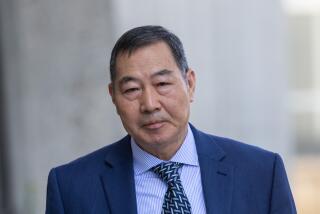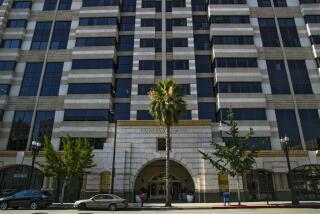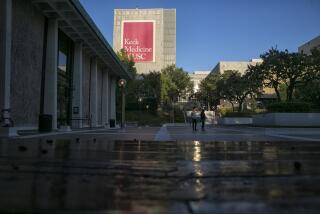Jury Begins Deliberations in Genentech Case
- Share via
The $445-million breach-of-contract suit against Genentech Inc. went to the jury Monday after closing arguments in which City of Hope attorneys accused Genentech of hiding lucrative deals to avoid paying the hospital huge royalties.
Attorney Morgan Chu charged Genentech with “a pattern of concealment and self help” that reduced by half the royalties City of Hope has received under a disputed 1976 research agreement.
Chu, of the Los Angeles law firm Irell & Manella, told jurors that Genentech licensed City of Hope technology to 22 drug makers since 1980 but never told the world-renowned cancer center about the deals. What’s more, Chu said, Genentech continually refused to answer letters from City of Hope inquiring about possible licensing pacts, raising questions about its “good faith.”
At the heart of the case is the historic 25-year-old contract that led to the invention of human insulin--the world’s first biotechnology drug. During the last two decades, City of Hope National Medical Center in Duarte has received more than $285 million in royalties on insulin and a second drug, human growth hormone, as a result of the 1976 pact. The two sides have wildly divergent interpretations of the contract, which assigned patents on City of Hope inventions to Genentech in exchange for research funding and royalties.
City of Hope points to language suggesting that Genentech must pay royalties on sales by companies that license the patents, which cover a pivotal method of producing bioengineered drugs. Genentech, citing other contract clauses, argues licensees must use not only the patents but also DNA--or genetic instructions for drugs--developed at City of Hope. The only medications that fit Genentech’s definition are insulin and human growth hormone.
Attorneys for Genentech, in their closing arguments, accused the hospital of trying to rewrite the contract. Jon Tigar, of the San Francisco law firm Keker & Van Nest, argued that when the contract was signed, City of Hope had its sights on funding for genetic research, not patents.
“A subsidiary of Revlon turned them down, the NIH turned them down,” Tigar said. “The only party in the whole world to come through for City of Hope was Genentech.”
Susan J. Harriman, also of Keker & Van Nest, told jurors that City of Hope wants several million more in damages than Genentech received in royalties from third parties for such medications as hepatitis B vaccine from GlaxoSmithKline.
The outcome of the six-week civil trial could produce a huge windfall for City of Hope and a substantial blow to Genentech, which isn’t expected to earn more than $410 million this year. City of Hope must receive votes from at least nine jurors to prevail on breach-of-contract allegations.
Jurors also must decide whether Genentech breached a fiduciary duty to act in the best interest of City of Hope, a finding that could result in punitive damages against the biotechnology company. The Superior Court’s Central Civil West courthouse, where the trial was held, is known for its huge damage awards. But any verdict in the 2-year-old lawsuit is likely to face an appeal. Genentech Chief Financial Officer Louis J. Lavigne Jr. told analysts in a conference call last week that “one or more appeals [will] push out the final resolution for some time.”
The trial often lacked drama worthy of the stakes involved. Testimony focused on dry correspondence between lawyers for City of Hope and Genentech, and on the meandering sentences of the contract itself.
Superior Court Judge Edward Y. Kakita at one point likened the tedious, videotaped testimony of one City of Hope witness to “watching paint dry.” The judge quickly reconsidered; the paint would be more exciting, he said.
Some key developments in the trial took place without the jury present. Kakita denied a Genentech request to throw out allegations that it breached its fiduciary duty to City of Hope. City of Hope won another behind-the-scenes round when it prevented a Genentech witness from offering a last-minute calculation that put compensatory damages at $7 million.
Outside the courtroom, the debate about numbers continued. Genentech Vice President Sean Johnston said in an interview that “financial trouble” motivated City of Hope to file the multimillion-dollar lawsuit. “To them, it’s a lottery ticket,” said Johnston, who said he found hints of problems when he did an Internet search.
City of Hope general counsel Glenn L. Krinsky responded that City of Hope will show an $18-million surplus for fiscal 2000. “We’re stronger than we have ever been,” he said.
Apart from testimony about the contract, jurors took in a scientific show-and-tell as each side touted its role in the discovery.
City of Hope biologist Arthur Riggs, co-inventor of the patent, inserted a tangle of magnetic cassette tape into a Kleenex box labeled “bacterial cell” to demonstrate how he and his colleagues slipped the genetic code for human protein into ordinary bacteria--the method later used to produce insulin. Genentech co-founder and former UC San Francisco biologist Herb Boyer later used a marker and easel to explain the same process with hastily drawn pictures.
Under cross-examination, former Genentech scientist David Goeddel--now chief executive of a biotechnology company called Tularik--said he should have been named with Riggs and City of Hope’s Keiichi Itakura as an inventor on the patents. Genentech’s attorneys decided to name only the two City of Hope scientists.
More to Read
Inside the business of entertainment
The Wide Shot brings you news, analysis and insights on everything from streaming wars to production — and what it all means for the future.
You may occasionally receive promotional content from the Los Angeles Times.










